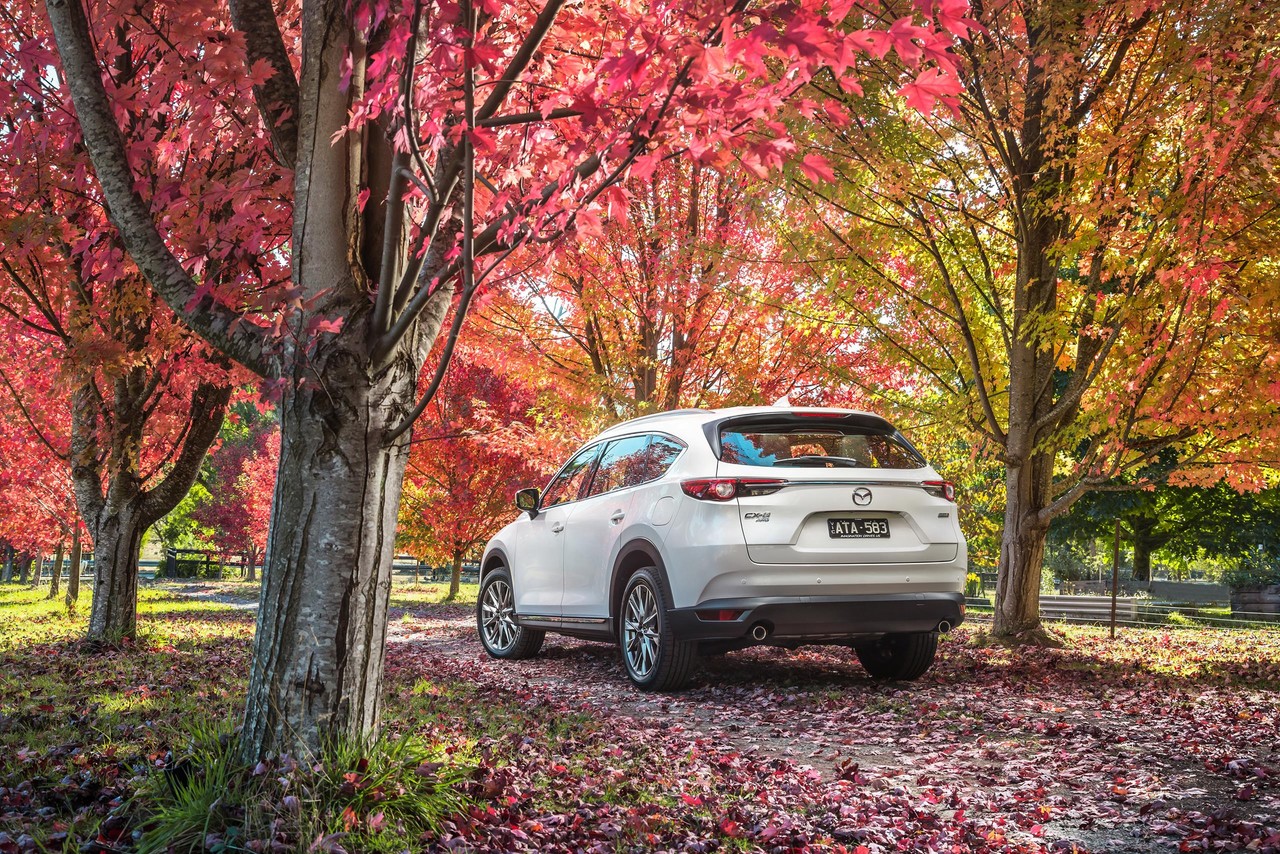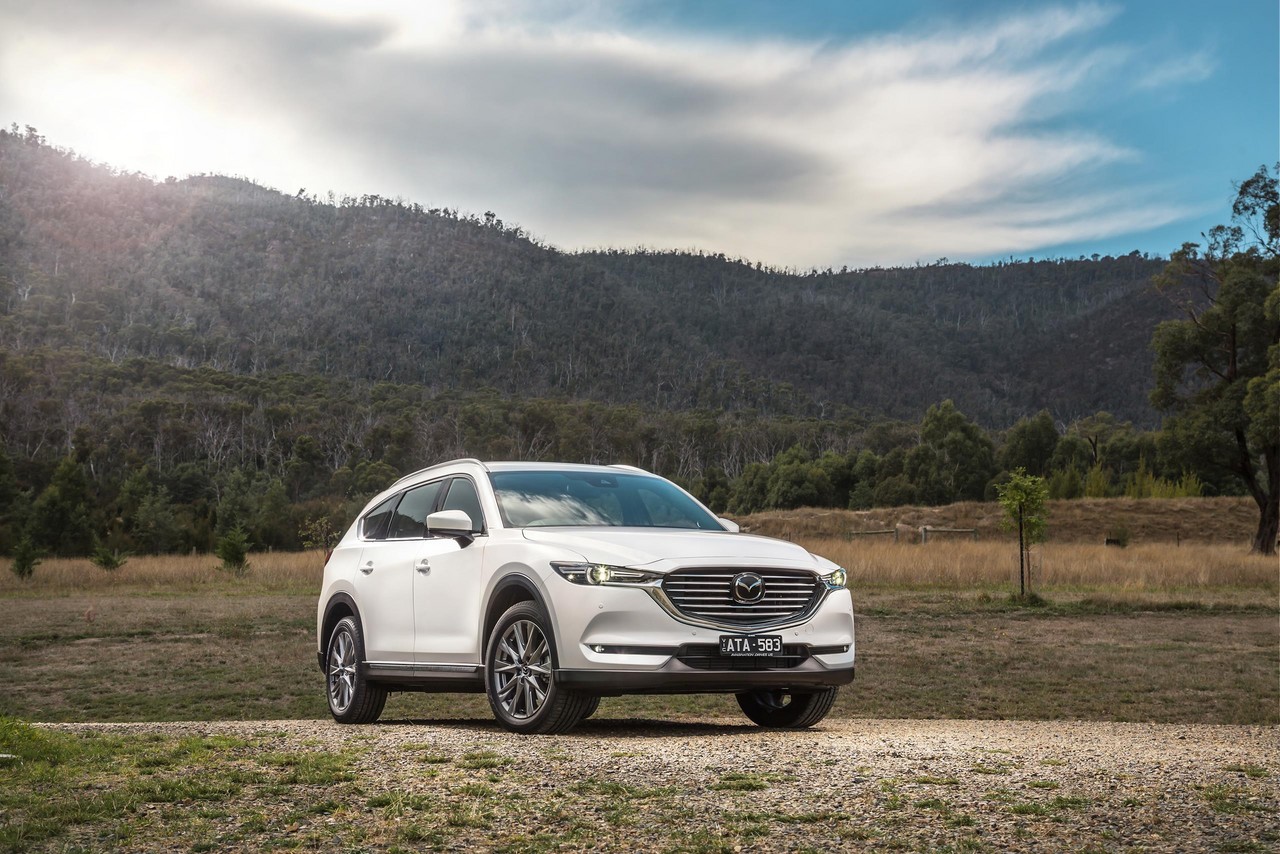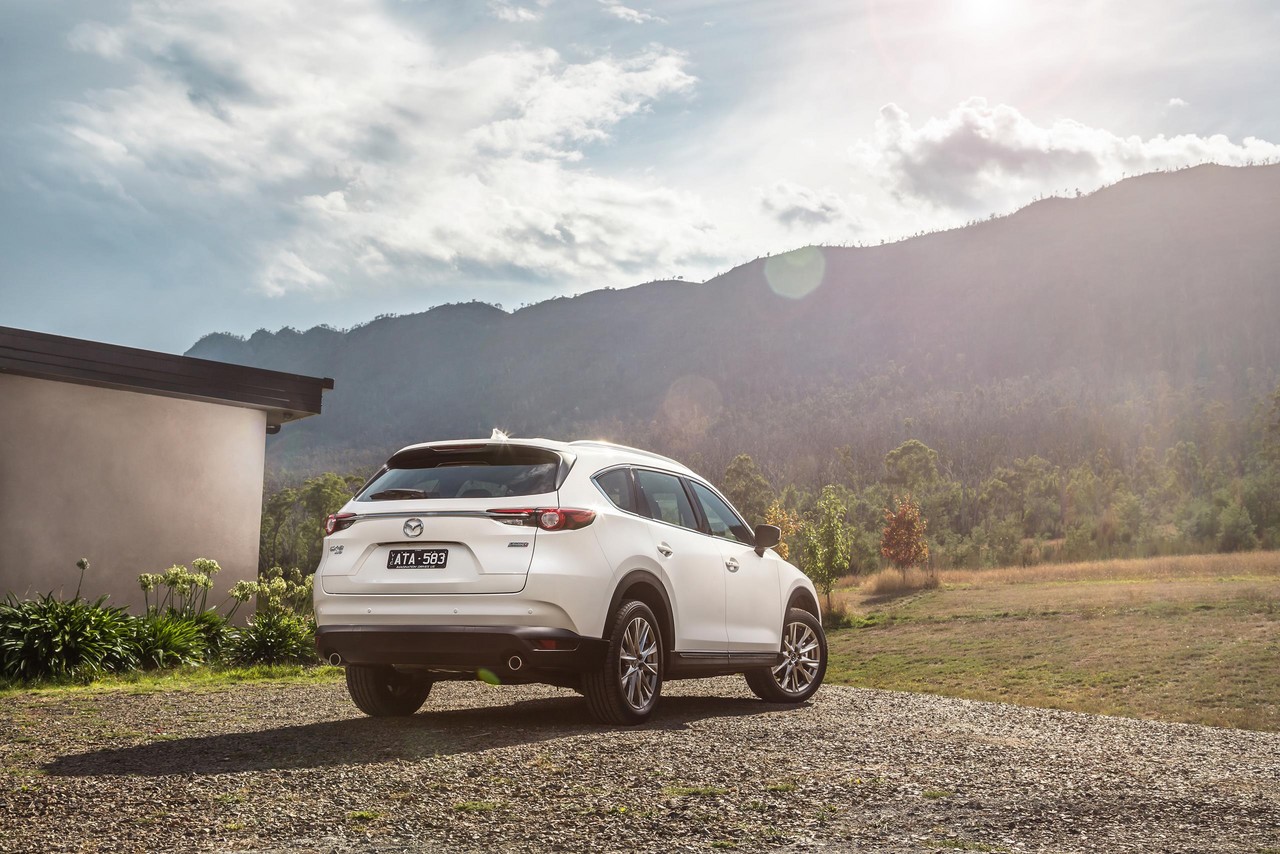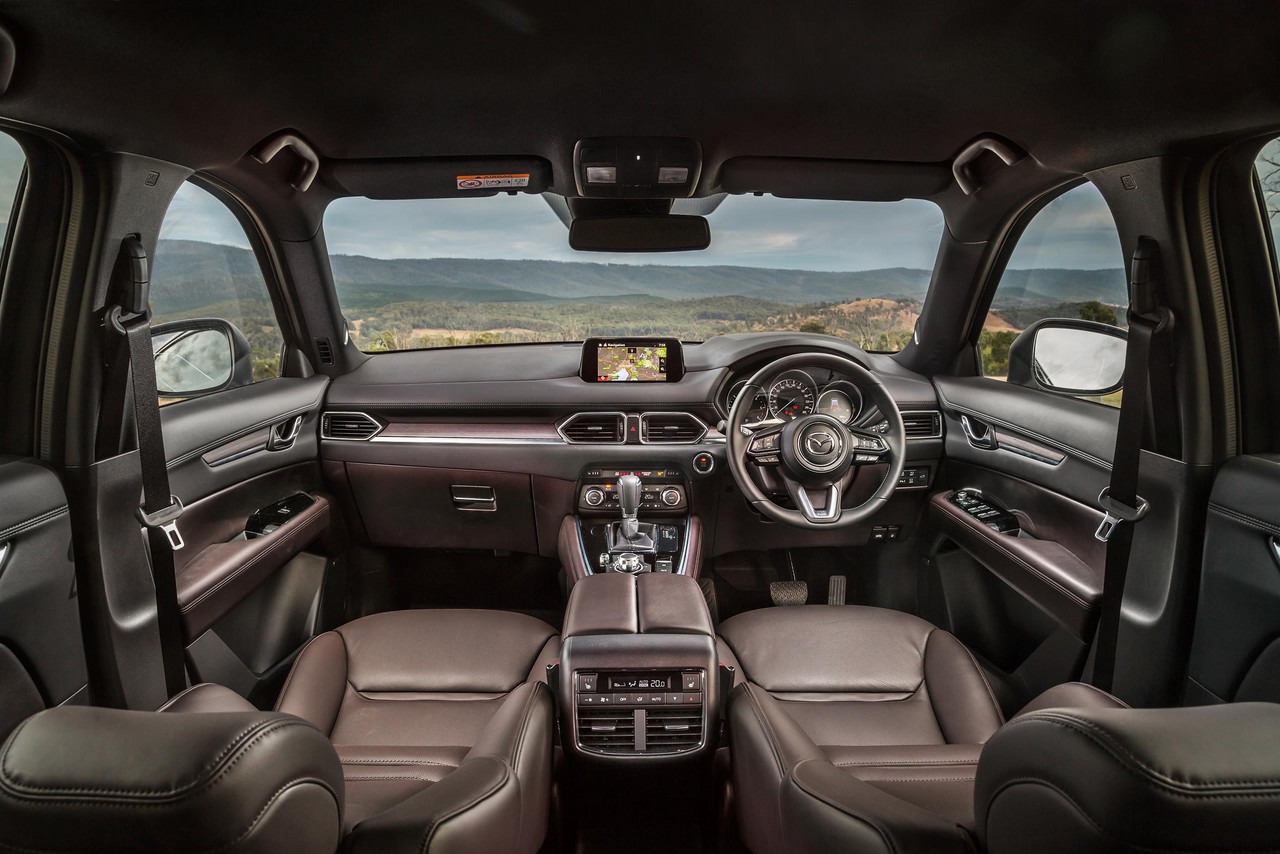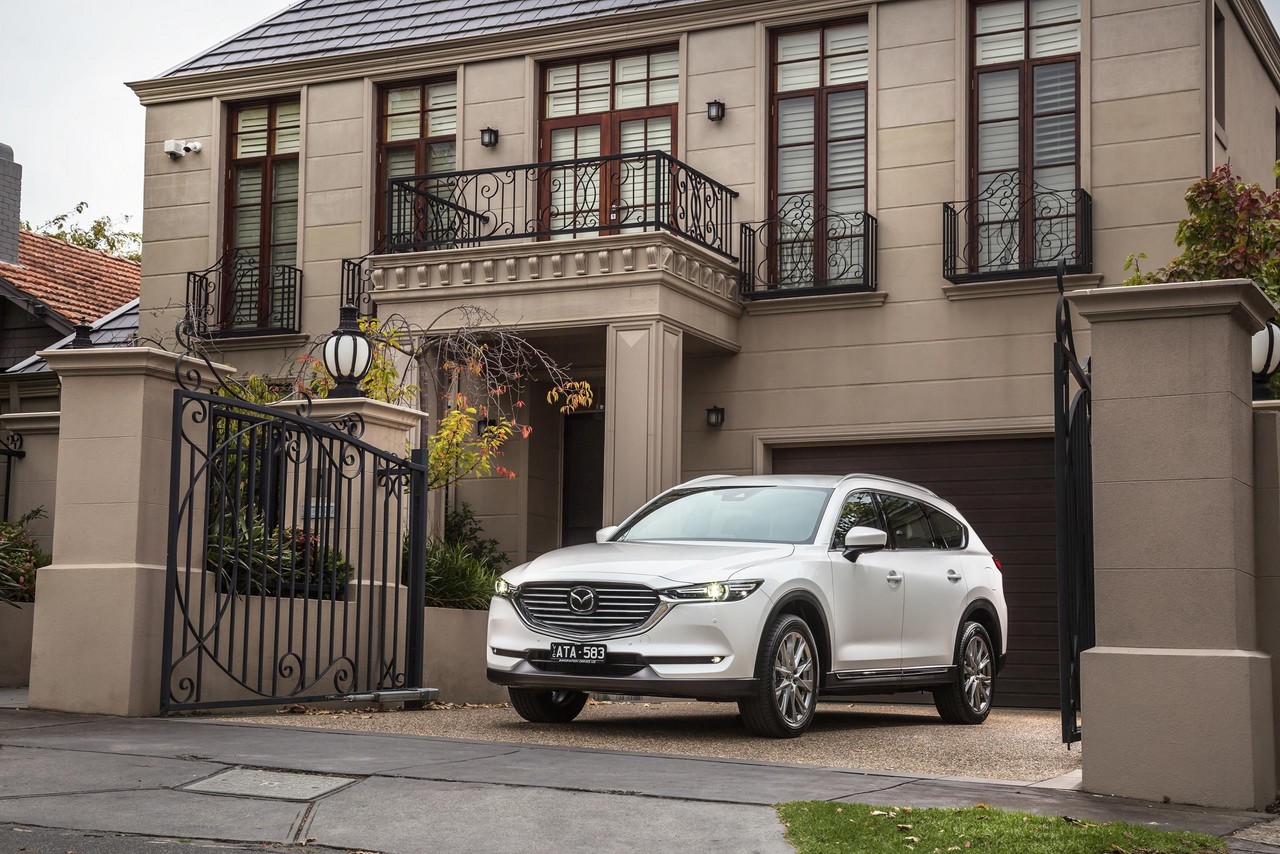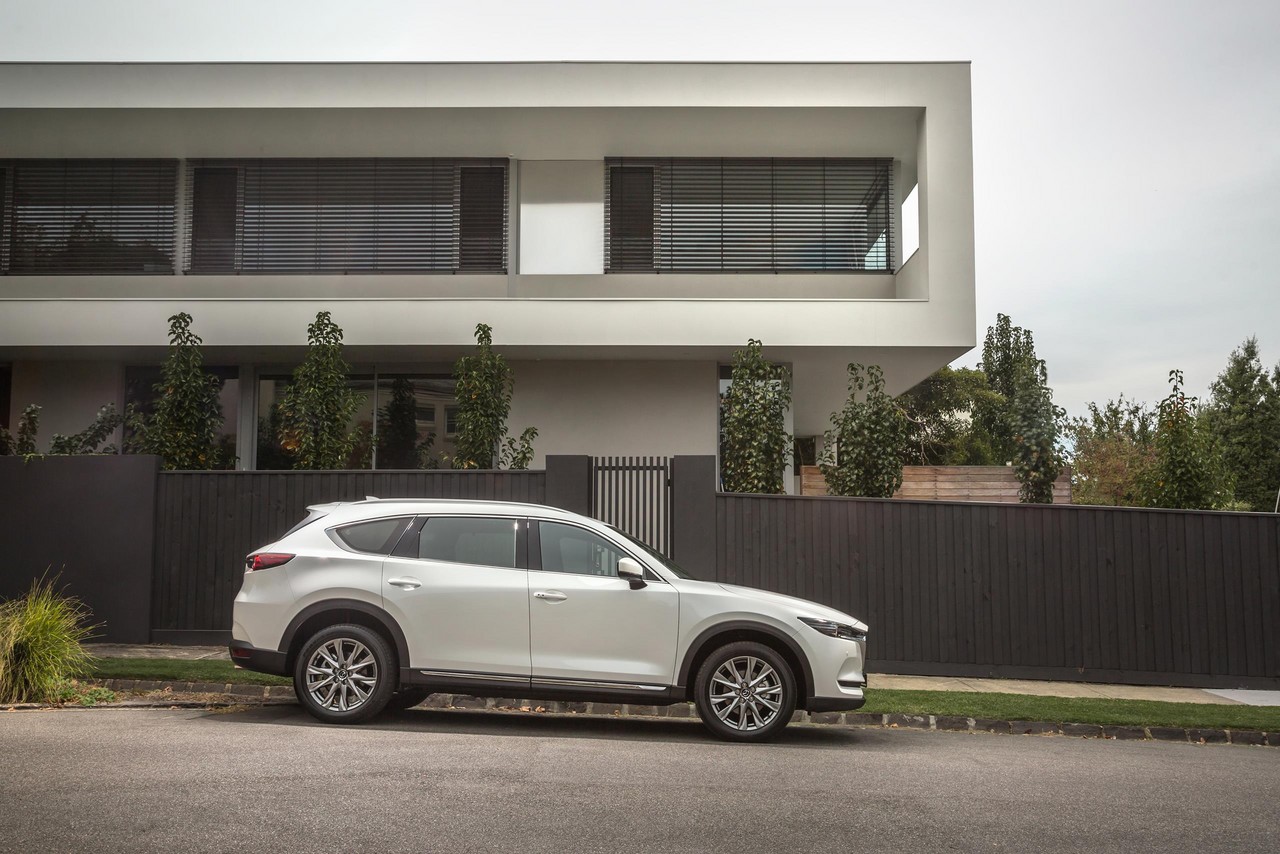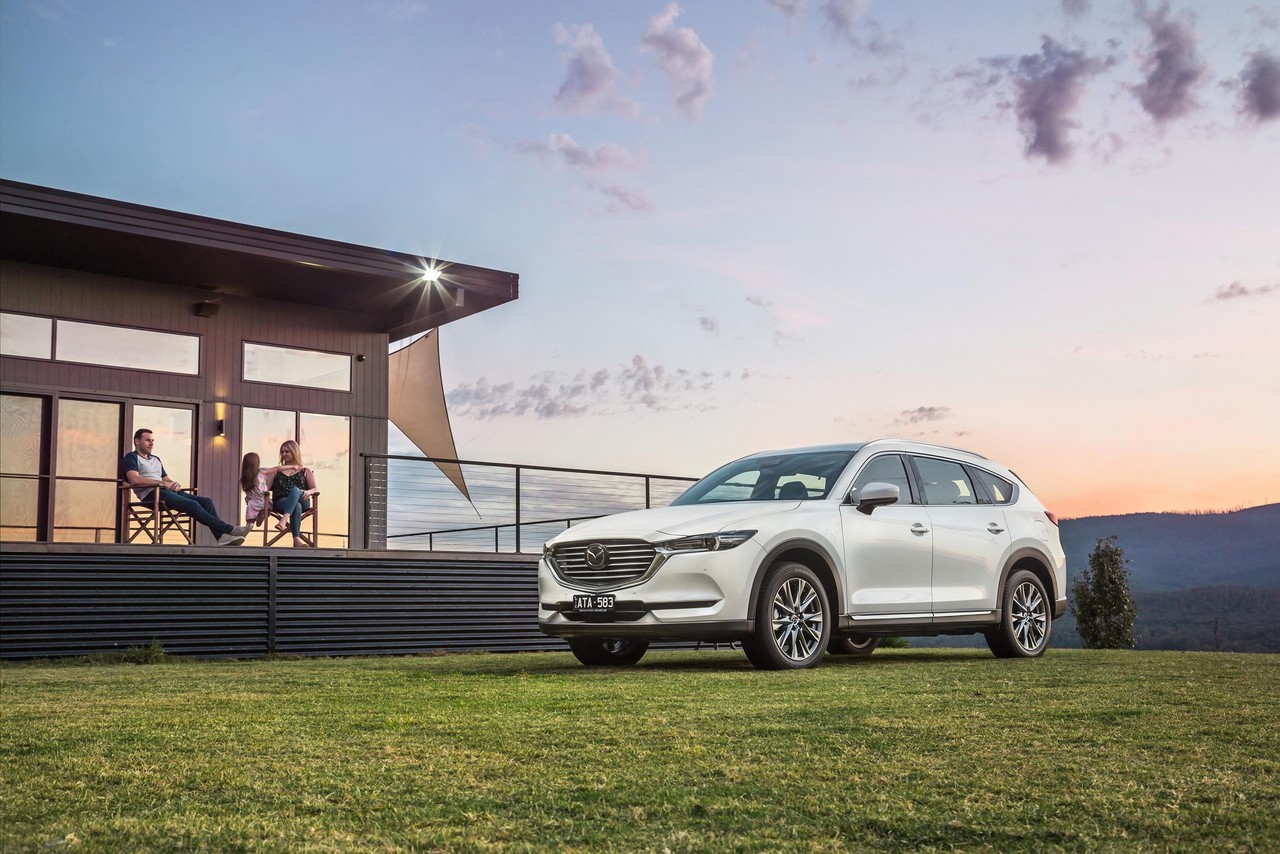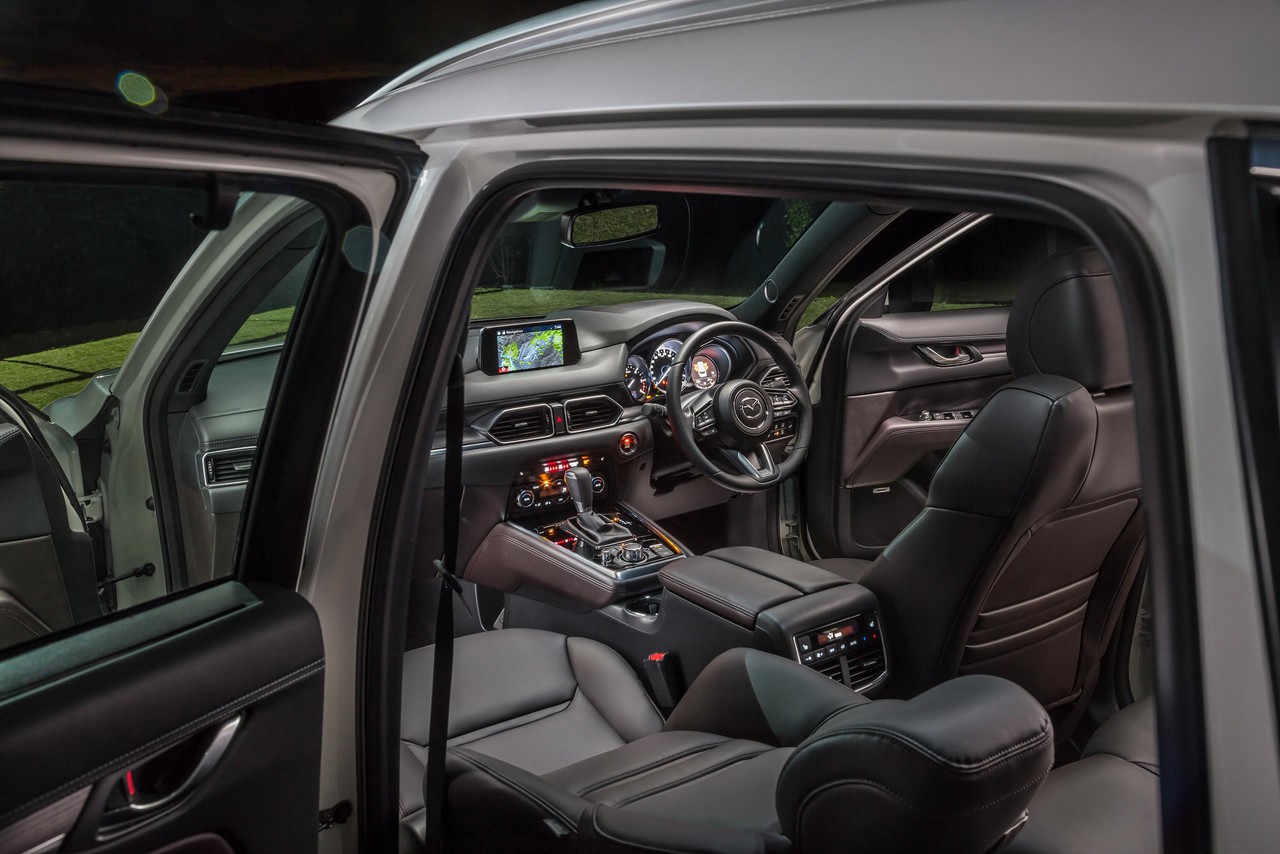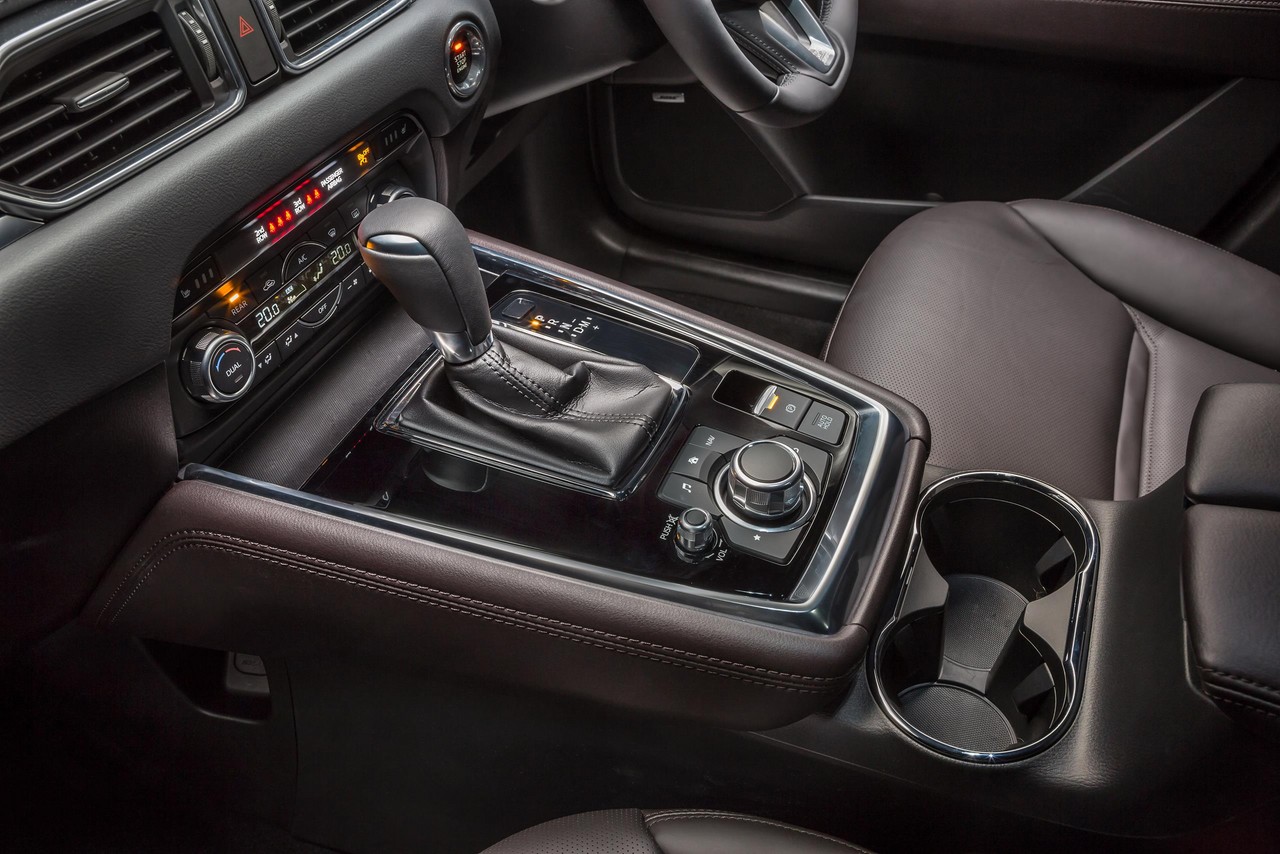
- Fuel-efficient 2.2-litre diesel engine
- Refined six-speed automatic transmission
- Array of active safety technologies fitted as standard
- Direct steering
- Generally impressive ride/handling balance…
- … though not as impressive for Asaki variants with 19-inch wheels
- Overpriced Asaki variants
- Cramped third row seats
- Poor image quality from 360-degree camera system
- Road noise
Overview
Released in Australia in July 2018, the Mazda KG CX-8 was a seven-seat SUV. Manufactured in Japan, the Mazda KG CX-8 was powered by a 2.2-litre turbo-diesel engine that was mated to a six-speed automatic transmission. For Australia, the Mazda CX-8 range initially consisted of front-wheel drive Sport ($42,490) and all-wheel drive Sport ($46,490) and Asaki ($61,490) variants.
In February 2020, the Mazda CX-8 range was expanded with the introduction of 2.5-litre ‘SkyActiv-G’ petrol engines and Touring and GT variants. The Touring and GT variants were positioned above the entry-level Sport variant, but below the range-topping Asaki variant.
2.2 SkyActiv-D diesel engine
The 2.2-litre SH-VPTR ‘SkyActiv-D’ diesel engine had an aluminium alloy block and cylinder head, double overhead camshafts, four valves per cylinder, common-rail direct-injection, two-stage turbocharging via two turbines (a smaller turbine for low rpm and a larger variable geometry turbine for more power when required), ten-port injectors and a compression ratio of 14.4:1. The SkyActiv-D engine also featured:
- Mazda’s ‘High-Precision DE Boost Control’ which provided more precise control of engine torque response by ‘optimising boost pressure control’ and enabling finer adjustment of fuel injection;
- Mazda’s ‘Natural Sound Smoother’ which sought to cancel piston vibration generated by extension and retraction of the connecting rod during combustion by placing a damper in the hollow part of the piston pin; and,
- Mazda’s ‘Natural Sound Frequency Control’ which reduced engine knock by controlling injection timing to within 0.1 ms so that engine vibration and structural vibration cancelled each other out (rather than combining).
2.5 SkyActiv-G petrol engine
The 2.5-litre ‘SkyActiv-G’ petrol engine had an aluminium alloy block and cylinder head, a balance shaft, double overhead camshafts, four valves per cylinder, variable valve timing for the intake and exhaust valves (Mazda’s ‘dual S-VT’), a 4-2-1 exhaust system with an extended manifold structure to reduce residual exhaust gas in the combustion chamber, a special piston cavity to reduce cooling losses, direct injection and compression ratios of 13.0:1.
| Engine | Drive | Variant | Trans. | Peak power | Peak torque |
|---|---|---|---|---|---|
| 2191 cc SH-VPTR biturbo diesel I4 | FWD | Sport, GT |
6sp auto | 140 kW at 4500 rpm | 450 Nm at 2000 rpm |
| 2191 cc SH-VPTR biturbo diesel I4 | AWD | Sport, Touring, GT, Asaki |
6sp auto | 140 kW at 4500 rpm | 450 Nm at 2000 rpm |
| 2488cc petrol I4 | FWD | Sport, Touring |
6sp auto | 140 kW at 6000 rpm | 252 Nm at 4000 rpm |
i-ACTIV all-wheel drive (AWD) system
The Mazda KG CX-8 diesel-powered variants were available with Mazda’s ‘i-ACTIV’ all-wheel drive system, a pro-active (or predictive) system which used two electro-magnetically controlled clutches mounted ahead of the rear differential. In normal conditions, the engine’s torque was primarily directed to the front wheels to minimise power losses and enhance fuel economy; ‘minute’ levels of torque, however, were sent to the rear axle to prevent backlash when additional torque was subsequently directed to the rear axle.
The i-ACTIV AWD system used twenty-seven (27) sensors to monitor driver behaviour and driving conditions, including:
- Vehicle speed;
- Accelerator position;
- Engine output;
- Acceleration and yaw;
- Steering angle and the electrical current of the steering system;
- Wheel slip;
- Gear selection;
- Brake fluid pressure;
- Road gradient; and,
- Ambient temperature and wiper operation (to determine if it was snowing or raining).
As a pro-active system, the magnetic clutches could be engaged when wheel slip was anticipated to direct torque to the rear axle, up to a 50:50 front:rear torque split. Furthermore, the i-ACTIV AWD command module calculated the desired front:rear torque split 200 times per second. To reduce friction, the AWD system used synthetic oil that maintains low viscosity even in cold temperatures.
Dimensions and body
While Mazda described the KG CX-8 as being positioned between the KF CX-5 and TC CX-9 , the Mazda CX-8 was effectively a long wheelbase version of the CX-5. Compared to the Mazda KF CX-5, the Mazda CX-8 was 350 mm longer (4900 mm), the same width (1840 mm), 55 mm taller (1730 mm) and has a 230 mm longer wheelbase (2930 mm). Relative to the Mazda TC CX-9 , the Mazda CX-8 was 175 mm shorter, 129 mm narrower and 17 mm lower, yet had the same wheelbase length.
The 60:40 split/fold second-row seats for the Mazda CX-8 had 120 mm of fore-aft adjustment and the backrest angle could be adjusted from 22 to 30 degrees (from vertical). According to Mazda, the folding third row seats were designed for occupants up to 170 cm tall. Behind the third row seats, luggage capacity for the Mazda CX-8 was 209 litres (VDA method), though a sub-boot below the main bloot floor had a depth of 100 mm and an additional 33 litres of capacity.When the 50/50 split fold third row seats were folded down and luggage was filled to the roofline, luggage capacity was 742 litres; folding down the second and third row seats increased capacity 1727 litres.
Suspension
The Mazda KG CX-8 had MacPherson strut front suspension and multi-link rear suspension.
Steering and G-Vectoring Control
The Mazda KG CX-8 had rack-and-pinion steering with a steering column-mounted electric motor for assistance. The Mazda CX-8 also had G-Vectoring Control (GVC) which reduced engine torque as the steering wheel was turned – usually by 0.01 g or less – to generate a small shift in load to the front axle. According to Mazda, this torque reduction improved cornering response by optimising the vertical load on each wheel.
From March 2019, the Mazda KG CX-8 was equipped with Mazda’s G-Vectoring Control Plus (GVC Plus). In addition to the reduction in engine torque of GVC, GVC Plus applied light braking force to the outer wheels when cornering as the steering wheel returned to the centre position, providing a ‘recovery moment’ to restore the vehicle to straight line running. As such, the vehicle was more stable after initial emergency avoidance actions and when driving on slippery surfaces.
Safety equipment
Standard safety equipment for the Mazda KG CX-8 included dual front airbags, front side airbags, full-length curtain airbags, ABS, electronic brake force distribution, brake assist, electronic stability control, traction control, active front seat head restraints and front seatbelts with pre-tensioners and load limiters.
As standard, the Mazda CX-8 was also equipped with the following active safety technologies –
- Smart City Brake Support (Forward/Reverse) with pedestrian detection (SCBS F/R): operating at speeds between 4 km/h and 80 km/h for vehicle detection and 10 km/h to 60 km/h for pedestrian detection, SCBS Forward used a near-infrared sensor that was mounted on the windscreen for ‘precision detection’ of objects up to six metres ahead of the vehicle. For SCBS Reverse, the system operated at speeds between 2 km/h and 8 km/h and used ultrasound sensors in the rear bumper to detect obstacles up to two metres behind the vehicle. When an obstacle was detected and a high risk of collision was assessed, the brakes would be applied automatically to avoid or reduce the severity of the collision (i.e. autonomous emergency braking or AEB);
- Smart Brake Support (SBS) with Forward Obstruction Warning (FOW): operating at speeds between 15 km/h and 160 km/h, SBS used a milliwave radar sensor and forward sensing camera to detect vehicles or obstacles on the road ahead. If a potential collision was assessed, an initial alert would sound (Mazda’s ‘Forward Obstruction Warning’) and the braking system would be pressurised. In its secondary phase, SBS applied the brakes lightly. If a collision was assessed to be inevitable, SBS increased braking force to minimise the severity of the collision. In the event that the driver applied the brakes, maximum braking force would be deployed;
- Mazda Radar Cruise Control (MRCC): operating at speeds between 30 km/h and 145 km/h, MRCC used a milliwave radar and forward camera to monitor the relative speed of and distance to the vehicle ahead. In accordance with the target speed set by the driver, MRCC adjusted vehicle speed to maintain a safe following distance. MRCC could also brake the vehicle until stationary and, if stationary for less than three seconds, would automatically accelerate when the car ahead started moving;
- Lane-keep Assist System (LAS) and Lane Departure Warning (LDW): operating at speeds above 60 km/h, LAS used the forward-sensing camera to monitor lane markings on the road surface and assisted the driver to stay in their lane by providing steering torque assistance and steering wheel vibration alerts. The driver could also choose from ‘Early’ or ‘Late’ settings to adjust the level of assistance and the timing of its operation. In the ‘Early’ setting, for example, the system provided continuous steering assistance to keep the vehicle in the centre of its lane;
- Blind Spot Monitoring (BSM): active at speeds above 10 km/h, BSM used 24 GHz milliwave rear radar sensors to detect vehicles approaching from behind the vehicle and in the driver’s blind spot. If the driver activated the indicators to change lanes while a vehicle was in the driver’s blind spot, a visual indicator in the respective door mirror would flash and a buzzer would emit an audible alert;
- Rear Cross Traffic Alert (RCTA): when the vehicle was reversing, RCTA used the rear radar sensors to detect traffic that may cross the vehicle’s intended path. If detected, a visual indicator in the respective door mirror would flash and a warning tone would sound;
- Traffic Sign Recognition (TSR): used the forward-facing camera to detect speed limit, ‘No Entry’ and ‘Stop’ signs while driving and display them on the Active Driving Display;
- Intelligent Speed Assist (ISA): if the vehicle exceeded the speed limit, the driver would be warned by blinking graphics on the display and an audible alert; and,
- Driver Attention Alert (DAA): operating at speeds above 65 km/h, the DAA system initially observed driver behaviour – such as steering wheel operation, vehicle speed and lane positioning – for 20 minutes to establish a benchmark. The DAA system then monitored driver behaviour for signs of fatigue and recommended rest breaks if detected. Furthermore, alerts would be issued if the driver had been driving continuously for more than two hours.
The Mazda CX-8 also had an ‘active bonnet’; in the event of a pedestrian collision, the trailing edge of the bonnet would rise to create additional space between the bonnet and hard structures in the engine bay, thereby reducing the likely severity of pedestrian injuries.
ANCAP safety testing
In ANCAP safety testing , the Mazda KG CX-8 received a five star safety rating which included a 96 per cent adult occupant protection rating and an 87 per cent child occupant protection rating. In the frontal offset test, protection of the driver’s head and thighs were rated as good, though chest and lower leg protection was rated as adequate (i.e. a slight risk of serious injury). In the side impact and pole tests, however, maximum points were awarded.
Wheels, tyres and brakes
The Mazda CX-8 Sport had 17 x 7.0J alloy wheels with 225/65 R17 102H tyres; the CX-9 Asaki, however, had 19 x 7.0J alloy wheels with 225/55 R19 99V tyres. As standard, the Mazda CX-8 had a temporary spare wheel (17 x 4.0T with a T155/80 R17 tyre).
The Mazda CX-8 had 320 mm by 28 mm ventilated front brake discs and 325 mm by 11 mm solid rear discs.
Features: Mazda CX-8 Sport
As standard, the Mazda CX-8 was equipped with a ‘MZD Connect’ infotainment system which included a seven-inch colour touch screen, satellite navigation, digital radio tuner (DAB+), auxiliary input (3.5 mm), USB audio input, Bluetooth mobile phone connectivity and audio streaming, and Internet radio integration (Stitcher and Aha). Also fitted as standard, Mazda’s ‘Active Driving Display’ (i.e. head-up display) projected information directly onto the windscreen in front of the driver such as turn-by-turn navigation, routing and speed limit information, current speed and safety warnings.
Standard features for the Mazda CX-8 Sport included a six speaker sound system, black cloth seat trim, three-zone climate control air conditioning, LED headlamps with auto on/off function, a rear-view camera, rear parking sensors, a leather-wrapped steering wheel and gear shift knob, 60/40 split fold second row seats, 50/50 split fold third row seats, remote central locking, power adjustable and heated door mirrors with auto-folding function, power windows, a height and reach adjustable steering column, an auto-dimming rear-view mirror, a 12 volt power outlet (cargo area), illuminated vanity mirrors, push-button start, roof rails, a trip computer and an immobiliser.
Features: Mazda CX-8 Asaki
Compared to the CX-8 Sport, the CX-8 Asaki was further equipped with a 273 watt Bose sound system with ten speakers and ‘AudioPilot 2’ noise compensation and ‘Centrepoint 2’ surround sound, dark russet nappa leather seat trim, a ten-way power adjustable driver’s seat with memory settings, a six-way power adjustable front passenger seat, heated front and outer second row seats, adaptive LED headlights, LED daytime running lights, LED front fog lamps, front parking sensors, proximity key, a heated steering wheel and a remote operated power tailgate.
As standard, the CX-8 Asaki was also equipped with a ‘360 degree View Monitor’ which used four cameras positioned around the vehicle to generate an overhead view of the vehicle that could be shown on the central display.
March 2019 update
In March 2019, the Mazda CX-8 was updated with a revised HVAC (heating, ventilation and air conditioning) control panel. Furthermore, standard equipment was extended to Apple CarPlay and Android Auto smartphone integration, and tyre pressure monitoring.
For the Mazda CX-8 Asaki, standard features were extended to include ventilated front seats, a seven-inch TFT LCD display, a frameless rear view mirror and LED ambient lighting. A more ‘streamlined’ overhead console was also introduced.
Visually, the post-March 2019 models could be identified by their LED license plate lamps. The CX-8 Sport models also had a ‘Grey Metallic’ finish for their 17-inch alloy wheels, while the CX-8 Asaki models had a ‘Brilliant Dark’ finish for their 19-inch alloy wheels.
February 2020 update: Touring and GT variants
As noted above, the Mazda CX-8 range was expanded in February 2020 by the introduction of 2.5-litre SkyActiv-G petrol engines and Touring and GT variants (positioned between the Sport and Asaki variants). Furthermore, more damping material was added to the roof to reduce interior noise.
For a complete list of features, please refer to the February 2020 brochure, below.
Brochure

